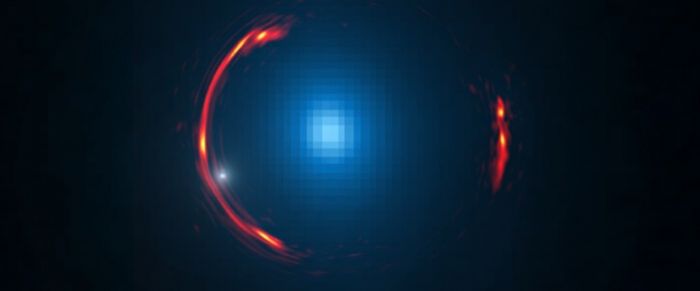 Composite image of the gravitational lens SDP.81 showing the distorted image of the more distant galaxy (red arcs) and the nearby lensing galaxy (blue center object). By analyzing the distortions in the ring, astronomers have determined that a dark dwarf galaxy (data indicated by white dot near left lower arc segment) is lurking nearly 4 billion light-years away. (Image credit: Y. Hezaveh; ALMA)
Composite image of the gravitational lens SDP.81 showing the distorted image of the more distant galaxy (red arcs) and the nearby lensing galaxy (blue center object). By analyzing the distortions in the ring, astronomers have determined that a dark dwarf galaxy (data indicated by white dot near left lower arc segment) is lurking nearly 4 billion light-years away. (Image credit: Y. Hezaveh; ALMA)
- Written by Stanford News
Stanford physicists help discover hidden dwarf dark galaxy
FeaturedThe discovery supports a powerful tool for discovering galaxies that are otherwise too distant to observe, and could lead to advances that improve our understanding of dark matter.
New analysis of an image taken by the Atacama Large Millimeter/submillimeter Array (ALMA) reveals evidence that a dwarf dark galaxy nearly 4 billion light-years away. In a new paper accepted for publication in the Astrophysical Journal, the team describes how detailed analysis of this image of a galaxy called SDP.81 uncovered signs of a hidden dwarf dark galaxy in the halo of a the more nearby galaxy.
"We can find these invisible objects in the same way that you can see rain droplets on a window: You know they are there because they distort the image of the background objects," said Yashar Hezaveh, a Postdoctoral Research Fellow in Physics and a member of the Kavli Institute for Particle Astrophysics and Cosmology at Stanford University. In the case of a raindrop, the image distortions are caused by refraction, but here similar distortions are generated by the gravitational influence of dark matter.
For their analysis, the researchers harnessed thousands of computers working in parallel for many weeks, including the National Science Foundation’s most powerful supercomputer, Blue Waters, to search for subtle anomalies that had a consistent and measurable counterpart in each “band” of radio data.
 Read the full article at Stanford News.
Read the full article at Stanford News.
Visible Legacy Comment
This basic science is exciting because it provides valuable new insights into the physics of dark matter and the structure of the universe. Tech Scouts might be interested in following two aspects of this project: the radiotelescope and the big data computation. The ALMA array consists of 66 radio telescopes observing at millimeter and submillimeter wavelengths working as an astronomical interferometer. Stanford has a history of significant innovation and impact from the field of radioastronomy, for example the field of Computer Aided Tomography (CAT Scans) by Ronald Bracewell. The use for data analysis of the Blue Waters petascale supercomputer at the University of Illinois at Urbana-Champaign is also interesting. These techniques of sensor arrays and distributed parallel computing are going to become more important over the next few years.
See the latest research from the ecosystem by exploring the map below!
Additional Info
-
Navigator:
 Explore the map in Navigator
Explore the map in Navigator - Widget:
- Caption: The Kavli Institute for Particle Astrophysics and Cosmology is an independent joint laboratory of Stanford University and the SLAC National Accelerator Laboratory, founded in 2003 by a gift by Fred Kavli and The Kavli Foundation. It is housed on the grounds of the SLAC National Accelerator Laboratory, as well as on the main Stanford campus. Roger Blandford was the director from 2003 until 2013. As of August 2013, Tom Abel is the acting director, Pat Burchat is the deputy director.
Related items
- The future of health care is in our cells
- Federal funding will help WSU professor develop technology to recover rare earth elements
- Unlocking the brain: Peptide-guided nanoparticles deliver mRNA to neurons
- Scientists Get to the Bottom of COVID’s Worst Pediatric Complication
- WSU-inspired national gene-editing task force begins work
